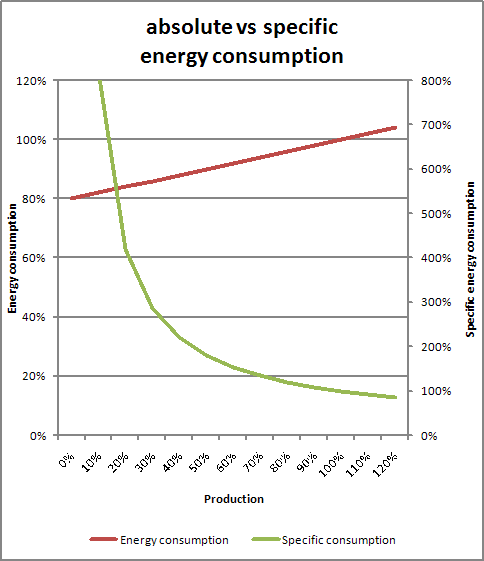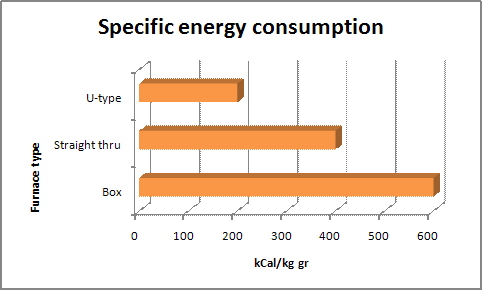The lowest possible energy consumption of an enamel furnace is achieved by :
-
selecting the most efficient furnace technology
-
determine the right furnace size
-
maintaining the furnace in a good condition by regularly performing preventive maintenance.
Specific energy consumption
The energy consumption of an enamel furnace may be
measured in absolute terms (e.g. nm3 gas, kWh and/or liters oil per
annum), but for bench marking purposes it is perhaps better to compare furnaces by their
specific energy consumption during operation.
This specific energy consumption is calculated by dividing the hourly energy consumption by the gross production. Click here to calculate the specific energy consumption of your furnace
The chart below show the relation between the absolute energy consumption, the specific energy consumption and the production. As expected the lowest possible specific energy of any furnace is achieved at maximum loading.

Influence of furnace design on the specific energy consumption.
The specific energy consumption of an enameling furnace is determined by the
following aspects:
-
Temperature of goods & firing tools when entering and leaving the furnace (hotzone)
-
Radiation losses from the hotzone to the preheating zone, respectively workshop.
-
Air leaks at hotzone and airstreams within entire furnace
-
Transfer efficiency of the heating system
-
Combustion efficiency and temperature of exhaust gases in case of a gas/oil fired furnace.
The impact of the first & second aspect is clearly visible when comparing the specific energy of respectively a box, straight thru and U type furnace. See indicative chart below.

The impact of radiation losses becomes also visible when comparing the specific energy consumption of S-shaped furnaces with "double hooked" or L-shaped furnaces with the same size & productivity. (See chart of various furnace shapes below)

Significant differences in heating-up time & energy consumption due to radiation losses may be observed by removing the "anti-radiation shields" of a proper functioning enameling furnace.
For this reason some companies experimented in the past with movable anti-radiation shields, which were attached to the furnace conveyor.
Warm air are goes up and therefore air leakage is typically found at the furnace roof. Notorious sources for energy losses due to air leakage are deformed shoeplates and/or shoeplates, which are made from the wrong material, and vapour exhaust holes which are too far open.
----
Ditmer Trading & Consulting BV assist companies worldwide by providing knowledge and independent advice about porcelain enameling technology, plants & equipment.
We also support users of Ferro Holland, Smit Ovens and/or Smit Sinus enameling plants & furnaces by providing practical maintenance advice and/or by sourcing critical spare, wear and tear parts.
Visit our website at www.ditmer.nl for more info about our B2B services and our contact details.